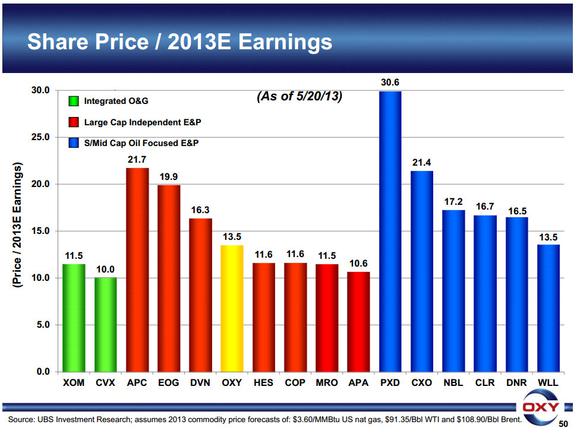Whether you’re looking for value, growth, income, or a combination of all three, the energy industry has something for every investor. That being said, it can be a little bit harder for the average investor to see the value here, because investing in energy requires you to drill deeper than the average valuation metric.
Most investors probably have some familiarity with a price-to-earnings ratio as a form of pegging a value on a company. Unfortunately, as you will soon see, it’s really not the best tool to use to gauge relative values when investing in an oil and gas producer. To demonstrate, let’s look at a chart that groups a number of well-known energy companies by P/E ratio:

Source: Occidental Petroleum Investor Presentation (Opens in a PDF).
Smaller oil-focused E&P company Pioneer Natural Resources (NYSE:PXD) trades at what would appear to be a rather expensive 30.6 times earnings. That’s about twice what Bakken-focused Continental Resources, Inc. (NYSE:CLR) trades at. Both appear to be valued much more expensively than larger independent E&P companies including Marathon Oil Corporation (NYSE:MRO) or Occidental Petroleum Corporation (NYSE:OXY), which could hurt your investing returns.
Drilling down, looking for value
The other thing to keep in mind when looking at a P/E ratio is that it tells only part of the story. Earnings could have been affected by one-time charges resulting from an asset impairment or gains on derivatives used in hedging out oil and gas price volatility. For example, last year, low natural gas prices cost Pioneer Natural Resources (NYSE:PXD) a total of $532.6 million after the company took several writedowns on its Barnett shale dry-gas properties. Meanwhile, Continental Resources, Inc. (NYSE:CLR) took more than $100 million in property impairment charges last year, however, that was more than offset by nearly $200 million in gains on derivatives last year. The volatility of commodity prices can really affect the earnings number, making the P/E ratio a less than optimal metric to use in valuing a potential investment.
A much better metric for an apples-to-apples comparison is the enterprise value-to-EBITDA ratio. This takes into account all of a company’s assets and debt and divides it by its earnings before interest, taxes, depreciation, and amortization. When looking at these same companies and applying that valuation metric, you get a very different investment story:

Source: Occidental Petroleum Investor Presentation.
In this case we can see that Pioneer Natural Resources (NYSE:PXD) is still actually pretty expensive on a relative basis, while Continental Resources, Inc. (NYSE:CLR) also possesses a high-end valuation. On the other hand, Whiting Petroleum Corp (NYSE:WLL) and Marathon Oil Corporation (NYSE:MRO) and very inexpensive on a relative basis. While this metric doesn’t tell you why these companies are cheap, it does provide you with a great starting point when investing with an eye for value.
Digging deeper for hidden gems
If you drill down a little further into these names, you find out that Marathon Oil Corporation (NYSE:MRO) could be cheap because it spun off its refining operations. That could have caused investors to sell off Marathon Oil Corporation (NYSE:MRO)’s stock to either load up on the refining arm or trade back into an integrated oil and gas company. The true value here is an oil and gas company with proven reserves of about 2 billion barrels of oil equivalents and a plan to grow its production by a compound annual rate 5%-7% through 2017. On the other hand, the company could be cheap because it has assets in Libya, which isn’t the safest place these days. Just like real estate, when investing for value in energy, it’s all about location.
The other name where a further drill-down is warranted is Whiting Petroleum Corp (NYSE:WLL). This oil-focused producer is heavily weighted to the fast-growing Bakken, yet it’s trading a lot lower than its peer group. What interesting is that not only does the company appear to be offering investors value, but it also has an enormous future drilling inventory, which includes more than 4,500 net potential drilling locations. For a company that’s projected to grow production by the mid-teens this year while also boasting of a fairly a strong balance sheet, it’s rather surprising how cheap Whiting is trading these days.
Final Foolish thoughts
A final thing to remember when investing in energy with an eye toward value is that sometimes value can really be hidden in plain sight just waiting to be unlocked. For example, many believe that the market is suppressing the value of Occidental Petroleum Corporation (NYSE:OXY)’s assets by as much as $47 billion. For a company with a market cap of $75 billion, that’s substantial, which is why the company is exploring the possibility of spinning off its international assets to unlock their valuer. Like Marathon Oil Corporation (NYSE:MRO), it has assets in Libya, which are probably weighing down the value of the company. This is where the smart investor can buy these assets at a compelling value and simply wait for a catalyst like a buyout or other strategic initiative to unlock the value.
The article A Guide to Finding Value When Investing in Energy originally appeared on Fool.com and is written by Matt DiLallo.
Fool contributor Matt DiLallo owns shares of SandRidge Energy and also has short September 2013 $5 puts on SandRidge Energy. The Motley Fool has no position in any of the stocks mentioned.
Copyright © 1995 – 2013 The Motley Fool, LLC. All rights reserved. The Motley Fool has a disclosure policy.






